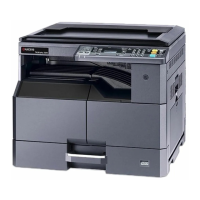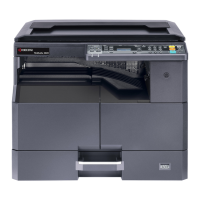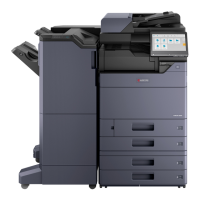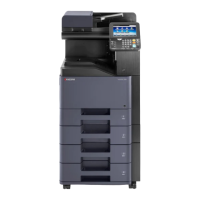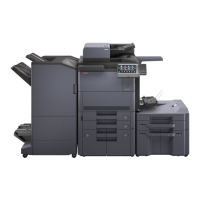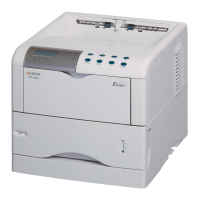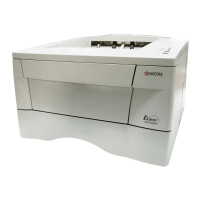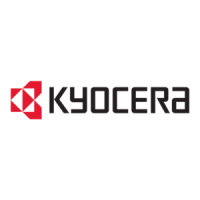
Do you have a question about the Kyocera TASKalfa MA4500ci and is the answer not in the manual?
| Category | Multifunction Printer |
|---|---|
| Technology | Laser |
| Print Speed (Black) | 45 ppm |
| Print Speed (Color) | 45 ppm |
| Max Print Resolution | 1200 x 1200 dpi |
| Duplex Printing | Yes |
| Scan Resolution | 600 x 600 dpi |
| Copy Speed (Black) | 45 cpm |
| Copy Speed (Color) | 45 cpm |
| Fax Speed | 33.6 kbps |
| Maximum Paper Size | A3 |
| Operating System Compatibility | Windows, macOS, Linux |
| Type | Color Multifunction Printer |
| Supported Paper Sizes | A4, A5, A6, Letter, Legal |
| Scanner Type | Flatbed and ADF |
| Network Connectivity | Ethernet, USB |
Explains safety warnings and symbols used in the handbook to protect users and ensure correct usage.
Provides an overview of the guide's content and sections, including what to refer to during use.
Details FCC rules and requirements for connecting equipment to the telephone network.
Basic safety precautions for using telephone equipment to reduce risks of fire, shock, and injury.
Technical specifications and Ringer Equivalence Number (REN) details for Canadian telecommunication equipment.
Lists attachment requirements for pan-European approval for connection to analogue Public Switched Telephone Networks.
Lists registered trademarks of software and companies whose products are mentioned in the guide.
Identifies and describes the main parts of the machine when used as a fax machine.
Explains the functions of the keys and indicators on the machine's operation panel.
Describes basic operations like tapping, popovers, and swiping on the touch panel interface.
Explains how to display a preview image of a scanned original on the panel before sending.
Describes how to enter numbers using the on-screen numeric keypad for destinations or settings.
Guides through the initial setup of essential fax system settings using a wizard.
Explains how to set the local date, time, and time zone for accurate fax transmission headers.
Describes how to save frequently used destinations for efficient fax transmission.
Explains how to assign destinations to one-touch keys for quick and easy access.
Overview of the Quick Setup screen for configuring frequently used fax send settings.
Explains how to register shortcuts for quick access to frequently used functions on the Quick Setup screen.
Explains the fundamental steps for sending a fax, including placing originals and selecting transmission methods.
Explains various ways to specify fax destinations, including numeric keys and selection from lists.
Describes how to select a fax destination from the machine's registered address book.
Explains how to select a fax destination assigned to a one-touch key for quick access.
Explains how to send the same fax to multiple destinations simultaneously in one operation.
Overview of various settings for configuring fax transmissions like original size, density, and resolution.
Allows scheduling fax transmissions for a specific time, which can be used with broadcast functions.
Sends faxes directly without scanning originals into memory first, allowing verification.
Allows sending originals after manually confirming the telephone line connection to the recipient.
Dials by linking fax numbers with a common chain number for cost-effective routing.
Explains how to set up automatic or manual fax reception based on machine configuration.
Describes the flow of automatic fax reception, including memory reception and print output.
Details the procedure for receiving faxes manually after confirming the telephone line connection.
Lists various functions related to receiving and printing faxes, like paper type and duplex printing.
Specifies the paper type to be used for printing received faxes from cassettes or trays.
Explains printing received faxes on both sides of the paper for efficiency.
Prints two fax pages onto a single sheet of paper to save resources.
Allows forwarding received faxes to other fax machines or computers, or specifying copy counts.
Configures the destinations and parameters for forwarding received faxes via email, folder, or fax.
Manages subaddress boxes for storing and retrieving received originals securely without printing.
Explains communication using sub addresses and passwords for secure data exchange.
Manages transmissions controlled by the receiving machine, supporting polling transmission and reception.
Manages received faxes stored in the machine's memory, allowing checking and selective printing.
Enables secure communication through encrypted transmission and reception of fax data.
Explains how to connect a telephone to the machine and use various functions like auto switch reception.
Allows automatic switching between phone and fax calls on a single telephone line.
Combines fax reception with an answering machine function for absent user scenarios.
Explains the sequence for sending faxes from a PC networked to the machine.
Provides a step-by-step guide for downloading and installing the fax driver from the website.
Explains the fundamental procedure for sending a fax via Network FAX from a PC.
Sets default transmission conditions like original size and orientation for the fax driver.
Describes how to modify transmission settings like destination and cover pages during the sending process.
Explains how to attach and transmit cover pages with faxes, including template selection and editing.
Allows verifying the status of and terminating active fax transmissions from the computer.
Displays the history of the latest send and receipt results for fax jobs on the screen.
Details the items shown and the functions of keys within the printing and sending job log screens.
Explains how to print administrative reports to check fax transmission results and functional setup status.
Explains how to print reports to confirm whether faxes have been received successfully.
Provides reports on sent and received faxes, listing the history of the latest 50 transmissions.
Provides information on user setups and fax-related settings, which can be printed as needed.
Explains how to receive fax receipt notifications via email instead of checking the receipt result report.
Explains fax settings accessible through the system menu, including Quick Setup Wizard and Fax Setup.
Configures overall machine operation settings, including display, sound, and paper feeding.
Configures settings for copying, sending, and document box functions, including fax-related defaults.
Registers local fax name, number, and ID for identification in transmit terminal identification (TTI).
Specifies paper types and settings for printing received faxes, including duplex and 2-in-1 printing.
Configures settings related to sending faxes, such as retry times, scan modes, and transmission speed.
Configures settings related to receiving faxes, including rings, RX start speed, and reception modes.
Registers encryption keys for secure fax communication, essential for encrypted transmission and reception.
Restricts fax communication based on registered numbers or IDs, controlling who can send or receive.
Limits communication parties by setting send and receive requirements, defining permitted or rejected contacts.
Sets specific time periods during which the machine will not print received faxes or perform other operations.
Manages user access and job accounting, specifying users who can use the machine and controlling usage per account.
Provides steps to take when the attention indicator flashes, guiding users to check error messages.
Lists common error messages displayed by the machine and their corresponding corrective actions.
Provides a detailed list of error codes encountered during transmission or reception and their possible causes.
Offers solutions for common operational problems, guiding users on checking symptoms and taking corrective actions.
Explains how to enter characters for names and other fields using the on-screen keyboard.
Lists the technical specifications of the fax function, including compatibility, speed, and resolution.
Provides a visual overview of the machine's menu structure, showing navigation paths to various functions.
Details paper priority for received faxes based on size and orientation for metric paper sizes.

